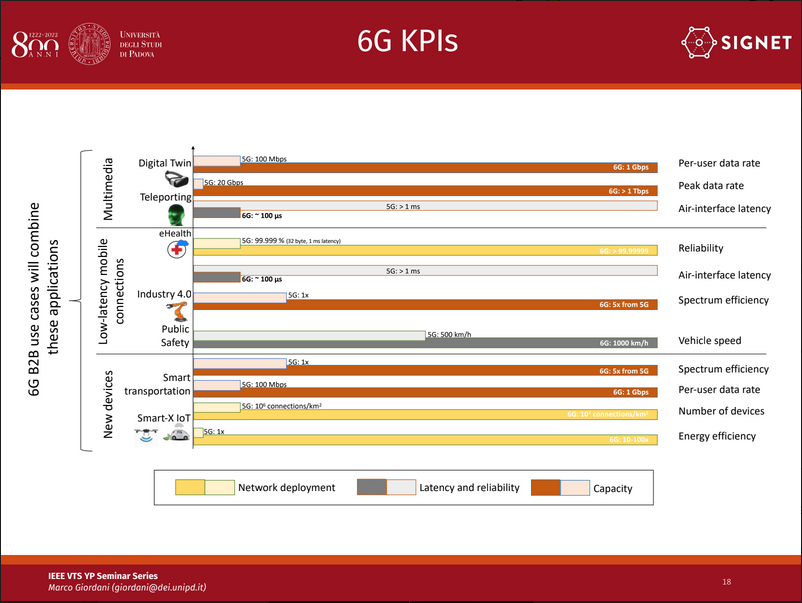6G is on the minds of many in the tech community, even in the early phases of 5G deployment. There’s a reason behind that, said Marco Giordani of the University of Padova’s SIGNET Research Group, during a presentation entitled “Toward 6G Networks: Use Cases and Technologies” on Tuesday.
“We expect the 6G standard to emerge around 2030. That’s why we need[…] to push research efforts right now, to draft the communication needs of the future, the performance requirements of the new use cases that will be enabled, and also which technological options can be developed in the context of 6G,” he said.
5G Car Trouble and 6G Solutions
It was the second seminar in the Institute of Electrical and Electronics Engineers (IEEE) Vehicular Technology Society (VTS) Young Professionals (YP) series. While not the specific focus of Giordani’s presentation, vehicles did understandably factor in prominently.
For example, the discussion shifted to high-frequency vehicle-to-vehicle (V2V) communication. While 5G technology is projected to leverage mmWave frequencies and 6G technology terahertz (100 GHz-10 THz) frequencies, Giordani said going even higher (400-700 THz) into the optic domain could unlock incredible automotive benefits.
“Here we can use light sources not only to illuminate the environment, but also to send data, to actually transmit information and the first advantage is that we do not need to develop very complex and expensive radio-frequency circuitry to make it feasible. We can simply use cheap [Light Emitting Diode; LED] devices. This is one of the reasons why there is already a standard for [Visible Light Communication; VLC] proposed by IEEE and that’s why the research is much more mature than it is for terahertz,” said Giordani.
Giordani did acknowledge that challenges exist. While he said indoor connectivity is a separate viable use case, once outside, “shot noise” from other light sources including the sun can interfere with communications. Regardless, it’s an area well worth the research work for V2V, Giordani noted in response to follow-up questions from 6GWorld™.
“Specifically, V2V communications will be designed to exchange a large amount of information among vehicles to enable advanced automotive services,” he commented. “If the use of mmWave spectrum is regarded as a viable approach to support the extreme data-rate demands, the mmWave hardware is very expensive and may not be able to be installed on low-budget vehicles. VLC can be easily deployed through the use of cheap LED devices, while large and unregulated bandwidth available can still satisfy the data-rate requirements of automotive applications.”
During his presentation Giordani had estimated 6G vehicular data-rate requirements in the range of terabits per second. Meanwhile, reliability is also an important consideration; Giordani reported seven-nines reliability (99.99999%) as a 6G target KPI.
Hitting 6G Targets with the Help of AI
With that level of reliability in mind, Giordani cited example applications in healthcare and Industrial Internet of Things, two sectors in which Ultra-Reliable Low-Latency Communications will also be front and centre. Giordani observed how artificial intelligence (AI) and machine learning (ML) would also be critical in helping to support stricter 6G requirements relative to 5G.

“AI so far supports control of the network. In the future, intelligence will play a different role. We are talking about enabling URLLC in extreme environments,” he said. “We are talking about integrating different types of devices together, like the drones, the smartphones, the sensors in the city, and the final goal is to support a fully autonomous network where there would be no need for human intervention any more.”
Giordani said end-to-end autonomy would revolve around machine learning. He singled out distributed learning, a relatively new concept, as being a likely factor in successful 6G. With distributed learning, the workload is spread across multiple machines instead of being centralised. Under the umbrella of distributed learning is federated learning, which Giordani said is gaining momentum. He explained that, there, each device trains a model using local data. Then, they share their model with one another instead of the data.
“It’s just much easier from a computational point of view,” he said, conceding that there are hurdles in the way. “Do we need to process the data on board? If yes, then how can we do that in real devices with battery constraints? If instead we delegate the burden of processing the data to some external cloud, then there is the latency for uploading this data to the edge of the network. This also goes against the requirements of very low latency of 6G. So, how to cope with this trade-off is still unknown and should be regarded as very important research for 6G.”
Ultimately, Giordani concluded by saying there’s undeniably an element of wait-and-see with regard to 6G. He argued that this represents the first time that telecom operators and vendors are diverging in terms of their priorities.
“Vendors are spending a lot of effort and money into developing new technologies that can be patented and sold. At the same time, operators have invested billions of dollars in 5G technologies, into buying licensed bands, and want to fully exploit the potential of 5G before looking into a new generation”
“They are not aligned toward the same path. So, we’ll see how 6G will go and we’ll see how the research will go in the next few years,” he said, expecting networks to first be operational around 2030-31 and adding we would have to wait 10-15 years for 6G, fully compliant with the standards on which researchers are now working toward, to be ubiquitous.
Feature image courtesy of Dmitry Demidovich (via Shutterstock).







